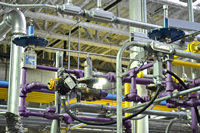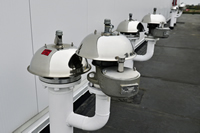When Sun Chemical expanded one of its facilities the company turned to L&J Technologies for assistance in installing vital safety equipment
Now more than ever state, local, and federal agencies are requiring facilities to control the amount of volatile organic chemicals (VOCs) and hazardous chemicals released into the environment. Today it’s vital that facilities equip themselves to help reduce fugitive emissions along with reactive, toxic, or flammable liquids and gases in processes involving highly hazardous chemicals.
Sun Chemical is the world’s largest producer of printing inks and pigments and a leading provider of materials to packaging, publications, coatings, plastics, cosmetics, and other industrial applications. During a period of plant consolidation, Sun Chemical expanded its Kankakee facility, located south of Chicago, Illinois, to enable the plant to manufacture inks for the packaging industry.The facility has 31 storage tanks that handle various solvents and nitrocellulose based resin solutions.
In order to stay in compliance with EPA regulations and the OSHA PSM programme, the Kankakee facility installed a number of Shand & Jurs products on their tanks. The plant is currently outfitted with Shand & Jurs’ 94270 Tank Blanketing Valve, the 94020 Conservation Vent, the 94307 Flame Arrester, the 94160 Pressure Relief Vent and the 94115 Side Mounted Vacuum Vent.
The Kankakee facility is currently set up with 17 indoor process vessels. These process vessels aid with large batch manufacturing systems. Each process vessel has a purple nitrogen line that attaches to Shand & Jurs’ 94270 Tank Blanketing Valve to inert a blanket of nitrogen over the product in the tank.
“With flammable materials the ability to use the [Shand & Jurs 94270] Nitrogen Tank Blanketing Valves allows a level of security to eliminate the oxygen from the environment which allows us to ensure safe operations,” Sun Chemical process engineer Rick Brown said.
The choice to introduce inert gas such as N2 into liquid process and storage tanks is a growing trend that allows for the prevention of product contamination and keeps the tank vapour space inert for safety considerations. Introducing inert gases, such as N2, is sometimes referred to as “blanketing” or “padding” the vapour space. Since the inert gas is supplied from a high pressure source and is being introduced typically into a low pressure tank, the selection of a Shand & Jurs 94270 Blanketing Valve accepts the high pressure gas and reduces the pressure to as low as 0.5″ WC for introduction into the tank, thereby eliminating the need for multiple pressure reducing regulators.
“Shand & Jurs’ 94270 Tank Blanketing Valve is essential in preventing emissions into the atmosphere and moisture from contaminating flammable product within a tank,” Shand & Jurs product manager Michael Landato says. “The 94270 maintains the equilibrium inside of the tanks by replacing oxygen in the tank with a high pressure inert gas, nitrogen in this case, to maintain a ‘blanket’ of constant low pressure gas above the packaging inks inside of the process vessels.”
The 94270 Tank Blanketing Valve is capable of sensing the pressure of the tank blanket and will open up to allow more gas when pressure drops below set point and close up once pressure reaches the desired set point. Reduced risk of product evaporation, emissions, combustion potential, corrosion, contamination and oxidation all make the 94270 important for conserving product, avoiding hazards and increasing plant safety. “Eliminating oxygen from process vessels is key to maintaining a safe operating environment. Ensuring that the pressure venting equipment [Shand & Jurs’ 94020 Conservation Vent and 94160 Pressure Relief Vent] works properly is key to safeguard against pressure build-up inside our equipment as well,” Rick said.
At the plant, large coated piping is connected to each of the process vessels and is channelled through the roof of the facility. Attached to the end of the piping is Shand & Jurs’ 94020 Conservation Vent and 94160 Pressure Relief Vent. Due to the process vessels being indoors, installing both the Conservation and Pressure Relief Vents directly on to the vessels could be a major safety and environmental hazard for the facility.
“The reason for having these vents installed to the piping on the roof is to avoid safety and environmental hazards. By allowing the equipment to vent to atmosphere allows Sun Chemical to maintain a safe working environment for workers and operations,” said eastern regional sales manager John Hutter. The 94020 Conservation Vent accommodates the pressure relief required during filling operation and thermal expansion. It also provides vacuum relief to protect the tank during product transfer from the tank and unpredicted gas blanketing disruptions.
The installation of pressure relief vents next to the conservation vents provides supplemental storage tank venting due to pressure surges. The 94160 Pressure Relief Vent’s set point should be above that of the Conservation Vent to act as a reliable back up in the case of an emergency. Often required by local regulations, using an additional relief vent can provide peace of mind about tank safety.
This article was featured in Storage Terminals Magazine.


5911 Butterfield Road, Hillside, IL 60162
by DQS Inc.